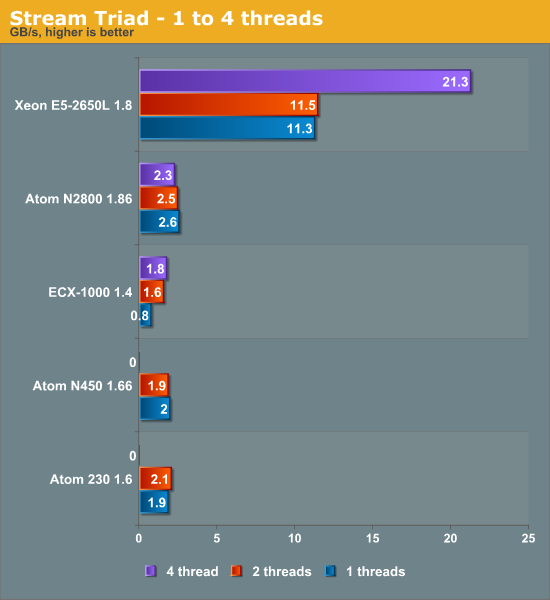Calxeda's ARM server tested
by Johan De Gelas on March 12, 2013 7:14 PM EST- Posted in
- IT Computing
- Arm
- Xeon
- Boston
- Calxeda
- server
- Enterprise CPUs
Measuring Bandwidth
Stream measures "sustainable memory bandwidth" and is thus a good indication of how a CPU will handle data intensive applications. Dr. John McCalpin is the developer and maintainer of the STREAM benchmark.
We compiled with gcc 4.7 on all platforms and used the -O3 -fopen -static settings. It is important to remark that this version of gcc has been optimized by the Linaro group, a non-profit software engineering effort. Linaro's objective is to optimize the kernel and typical tools for the ARM-Cortex A-series CPUs.
On the Intel CPUs we force the threads to make use of Hyper-Threading with taskset. So for example, the four threads measurement is done on two physical cores with four threads. This gives an idea of how a quad-core ARM server node compares to a virtual machine that gets a few physical and few logical cores from the hypervisor. It also allows us to evaluate how two threads on top of an Atom core compare to two ARM cores. When you compare CPUs with similar power consumption, you typically get two ARM cores for each Hyper-Threaded Atom core.

The ARM based server is a pretty bad choice right now for memory intensive workloads. Even with four cores and DDR3-1333, the useable bandwidth is less than one sixth of what one Xeon core can sustain.
In a similar vein, the ECX-1000 is not capable of providing more bandwidth than an Atom system equipped with DDR2-667. However, both the Atom and ARM cores are pretty bad when it comes to bandwidth. Although the specs claim that the CPUs can drive one channel of DDR3-1066, the measured bandwidth comes nowhere near the theoretical 8.5GB/s that such a DIMM can deliver.










99 Comments
View All Comments
Gigaplex - Tuesday, March 12, 2013 - link
I wouldn't call that a spectacular performance per watt ratio. It's a bit faster than the Xeon under a cherry picked benchmark (much slower under others), and is only marginally lower power. Best case it's an 80% improvement over Sandy Bridge with regards to performance per watt, and Atom wasn't represented. Considering all the hype, I was expecting something a little more... exciting. Ignoring Ivy Bridge improvements, Haswell isn't far off.spronkey - Tuesday, March 12, 2013 - link
Yeah... I agree. It also only seems to really come into its own in high concurrency. The Xeons idle quite similarly in terms of power - what happens if you compare it to more Xeon cores? It seems like on a per core basis, Intel still has the advantage on both fronts?spronkey - Tuesday, March 12, 2013 - link
I would also point out that the A15 has already been compared against Sandy and Ivy cores and come up short in performance per watt; so I'm very interested to see what the next step for these ARM node servers is.JohanAnandtech - Wednesday, March 13, 2013 - link
I warned against the hype in the first sentences. :-) ARM CPUs are still rather weak and not a good match for most applications. However, the fact that we could actually find a case where they do a lot better than the current Xeon systems was surprising to me.wsw1982 - Wednesday, April 3, 2013 - link
No, it should not surprise any people regarding how picky the use case is. I mean, I do think you can find a use case the ARM 11 output perform Xeon. E.g. Serving 1 web request per hour :)LogOver - Tuesday, March 12, 2013 - link
24 servers ran inside 24 VM's on Xeon server, while for ARM server you used the 24 physical server nodes... Hmm... Does not seems to me like apple to apple comparison. Why not to compare, for example, 16 physical nodes on both, xeon and arm servers?haplo602 - Wednesday, March 13, 2013 - link
And how do you slice the Xeon server into 16 physical nodes ? It does not support any kind of HW partitioning that I am aware of. On the other hand the Calxeda machine is a cluster by design. If you try 16 Xeon nodes you'll go through the roof with power.Colin1497 - Wednesday, March 13, 2013 - link
I think the question is this:Was 24 VM's optimal for the Xeon? Since we're visualizing the Xeon, why 24? Just because you had 24 ARM nodes? Would the Xeon done better with 4VM's? Or 16? Or 1000? 24 seems arbitrary.
JohanAnandtech - Wednesday, March 13, 2013 - link
We tested with 16 as I briefly mentioned in the conclusion. The 2650L did 170 responses/s per VM, or about 40% better. Total Throughput = 2.7k/s, while with 24, 2.9 K/s. THe flexibility that the Xeon has to reduce the number of VMs if higher throughput is necessary is definitely an advantage, but the performance numbers are not that different with different VM configs.Kurge - Wednesday, March 13, 2013 - link
How about with 0 VM's? Just run it on the metal.